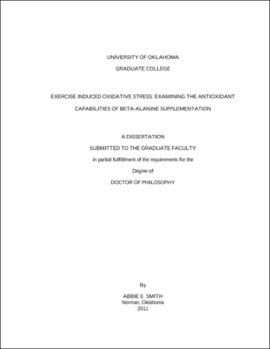| dc.description.abstract | PURPOSE: The primary purpose of this study was to evaluate the effects of twenty-eight days of beta-alanine supplementation on markers of oxidative stress in men and women. METHODS: Twenty-five men (Age: 22.0 ± 3.3 yrs; maximal oxygen consumption (VO2max): 3.9 ± 0.5 l*min-1) and twenty-four women (Age: 21.7 ± 2.1 yrs; VO2max: 2.6 ± 0.3 l*min-1) volunteered to participate in this double-blind, placebo-controlled study and were randomly assigned to a beta-alanine (BA, 2 x 800 mg tablets, 3 x per day; CarnoSyn®, Natural Alternatives Inc, San Marcos, CA; n= ) or placebo (PL, 2x 800 mg maltodextrin tablets, 3 x per day; n=) group for twenty-eight days of supplementation. A maximal graded oxygen consumption test (VO2max) on a treadmill was performed to evaluate VO2max, time to exahustion (VO2TTE), ventilatory threshold (VT) and to establish peak velocity (PV). Baseline blood draws were taken before, immediately post (IP), 2h post and 4h following a 40 min treadmill run at 70%PV to evaluate total antioxidant capacity (TAC), superoxide dismutase (SOD), 8-isoprostane (8ISO) and reduced gluthathione (GSH). Heart rate and ratings of percieved exertion were recorded during the 40 min run. Separate four- [4 × 2 × 2 × 2; acute (base vs. IP vs. 2h vs. 4h) × chronic (pre- vs. post-) × treatment (placebo vs. beta-alanine) × sex (male vs. female)] and two- [2 × 2; time (pre-supplement vs. post-supplement) × treatment (placebo vs. beta-alanine)] way ANOVAS were used to identify and group by time interactions for oxidative stress markers and aerobic performance, respectively. RESULTS: Both groups demonstrated significant improvements (p<0.05) in VO2max. Percent change scores revealed a significant increase in VT for the male BA group. Heart rate and ratings of perceived exertion values were significantly improved from pre- to post-supplementation for the BA group, while the PL group demonstrated non-significant negative changes. There was a significant (p<0.05) exercise induced oxidative effect on all markers. The chronic effects of BA supplementation suggest there is an antioxidant effect on 8-isoprostane and GSH, with no gender differences (p<0.05). CONCLUSIONS: The current findings support previous performance research, demonstrated the ergogenic benefit of BA on VT. Additionally, an exercise-induced oxidative stress response, from a 40 minute treadmill run, may be slightly attenuated following twenty-eight days of beta-alanine supplementation for markers of lipid peroxidation and reduced glutathione, for both men and women. | |
